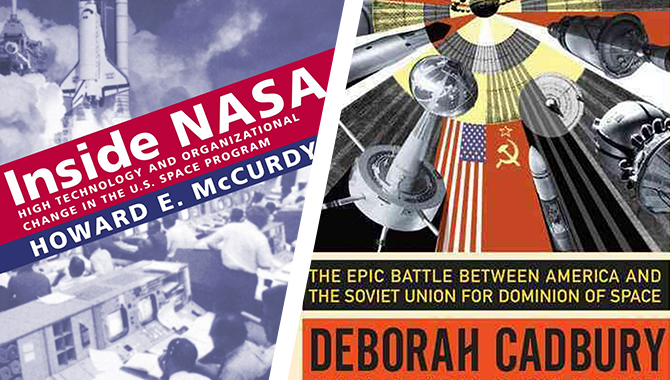By Gus Guastaferro
Early in my career, just after I completed a special task on the development of the gas chromatograph mass spectrometer for the Viking lander, Viking project manager Jim Martin asked me to go to Denver to manage the day-to-day activities of the all-up systems test on the entire lander. This meant I needed to find a replacement to carry out the final stages of the spectrometer instrument testing. I assigned the lead systems engineer, Al Diaz, as the spectrometer project manager, giving him the opportunity to take on responsibility for the instrument through launch and flight operations. He met the challenge outstandingly and went on to a strong thirty-year career in NASA executive leadership. The new responsibility Jim gave me helped both me and Al develop our skills and advance our careers.
Looking back on my NASA and industry career in project management and executive leadership, I am struck by the opportunities I was given by supervisors who cared about developing future leaders for the Agency. They made a point of providing growth opportunities and on-the-job mentoring that helped me realize my leadership potential. While meeting the mission objectives of a program or enterprise task, I had opportunities to take on responsibilities and make decisions at a level that helped me grow as a manager.
Project and program management focuses — as it should — on getting the job done, but managers are also responsible for helping promising individuals on their teams develop their skills and their careers. That attention is important to their futures and the future of the Agency.
The Challenge
Project and program leaders must accomplish their mission objectives by using assigned resources effectively. This challenging responsibility includes assigning key technical and administrative personnel to roles that can last a decade or more, assignments often made during the formative part of a career. So project leads must recognize team members’ career development needs as well as their direct contributions to the success of the enterprise. Good leaders devote a significant amount of time to devising career development plans with each high-potential person and establishing formal practices for finding program opportunities that promote career growth.
The project leader and the individual team member should enter into an agreement that directs primary attention to mission success but includes a specific plan for individual development. The agreement should provide a framework for rewarding performance and dedication to the mission with a commitment to provide increased responsibilities that lead to career growth opportunities. I suggest that the project leader and the team member maintain a mentor relationship and continuously assess overall performance.
Resources and Responsibilities for Leadership Development
NASA’s strong training and certification programs are an important developmental resource, and every opportunity should be taken to send promising members of a project team to the project management and advanced project management courses at Wallops and other NASA facilities. At the same time, supervisors need to design and structure opportunities within projects to expose high-potential team members to greater responsibilities on the job, giving them hands-on challenges that stretch individuals and promote learning and confidence.
These assignments need to be carefully monitored for progress and possible adjustment, preferably by continuous mentoring during the on-the-job training experience. Here, too, the Academy of Program/Project and Engineering Leadership’s pool of specialists in project leadership can be helpful, providing mentoring that includes elements of the soft side of technical leadership — skills including listening, exhibiting vision, recognizing others, ethics, and time management. The project leader’s responsibility is to recognize the need and request the support.
Lessons from Viking
During work on a high-visibility project, day-to-day problems tend to take priority over career development, but an apparently hopeless problem within a project can be turned into an opportunity to achieve career development goals.
In early 1973 for instance, during the Viking Project development phase, it became clear to Jim Martin that challenges in manufacturing and testing were delaying development of a critical science instrument designed to measure the organic chemistry on the surface of Mars. It seemed almost certain that this compact, sophisticated instrument would not make the 1975 launch target. Martin’s solution both satisfied mission objectives and created a career development opportunity. He requested that I accept the challenge of completing the instrument development and use it as an opportunity to develop my project management skills.
At the time of the reassignment, I was Martin’s Deputy Project Manager for Management Operations. My new assignment gave me direct authority over the three hardware contractors and a technical interface with the assigned scientist. I temporarily relocated to Southern California so I could spend enough time at the contractor’s facilities to understand everyone’s role in the project and develop a list of the top technical and operational issues. I redefined assignments with each member of the team and set up a daily meeting to assess progress against plans. I also found that giving Litton Industries system integration responsibilities over Perkin Elmer and Beckman Industries was critical to tying the three major hardware elements together. Becoming a knowledgeable customer and adding frequent assessment of progress improved communications and allowed for effective decision making. With the help of a very dedicated team of NASA, academic, and contractor personnel, I met the objective of completing the instrument development on time.
My supervisor gave me an opportunity to develop as a seasoned project manager, building confidence to continue my career as a major contributor to NASA. Also, his actions served as a model for how I would treat the people assigned to me in the future.
Viking also provides an example of how solving a difficult personnel decision involving one of your key people can turn into a career development opportunity for another. In 1972, the mission director assigned to the Viking Project received a Sloan Fellowship to attend Massachusetts Institute of Technology (MIT) for a year. Martin felt that losing Tom Young at this critical time could adversely affect planning for the 1975 mission operation phase of the program. Nevertheless, he chose to turn the challenge into an opportunity for two of his key people. He allowed Young to attend the program and assigned Dr. Howard Robins as his replacement for the year. The decision entailed risk, but I believe Jim Martin had full knowledge of Dr. Robins’ potential. And he used the time between Young’s selection and his departure for MIT as an opportunity for Robins to become familiar with the current challenges and understand his new responsibilities. Had he found that Dr. Robins was not up to the challenge, he would have made a midcourse correction. As it happened, the project was well served and two future NASA and industry leaders were developed as a by-product of the Viking mission to Mars.
Other Shared Experiences
When I left Langley Research Center to assume the position of Director of the Planetary Division in the Office of Space Science at NASA Headquarters in the early 1980s, I inherited an existing staff of technical, scientific, and administrative personnel. One of those people was a very young secretary who recently had left college to start a career at NASA. She clearly demonstrated natural skills above her assignment. I requested that she apply for a vacant position as my administrative assistant. She got the position and did an exceptional job. She also agreed to return to an evening undergraduate program while continuing to perform her duties. Eventually, she went on to receive her master’s degree and attend the Harvard University Program for Government. Today, she is a key member of the executive corps of NASA. I don’t take credit for her success, but I believe that recognizing and encouraging her ability helped get her started. I was helping her in the same way I had been helped years before.
A final story: As a vice president at Lockheed Martin, I supervised project managers assigned to a variety of NASA programs. In one case, it was obvious that the Lockheed Martin project manager who provided the clever design that won a contract for one of the first Discovery Missions of the NASA Space Science Program had a conflict with the project manager assigned by NASA. I turned this problem into an opportunity by assigning an outstanding systems engineer from the Hubble Space Telescope to complete the development and launch of this very critical program and giving the very bright and capable engineer who provided the winning design a new assignment that helped advance his career. As a result, the mission succeeded and two professional technical careers advanced.
Leaders Developing Leaders: Some Lessons Learned
1. Never lose your capacity to make difficult decisions and to change.
2. Never judge or classify assigned people too quickly; assume competency.
3. Be willing to replace the weak, mentor the marginal, and reward the achievers.
4. Be generous at all times; treat everyone with professional dignity.
5. Remember that the greatest builder of confidence is to complete difficult tasks successfully.
6. Accept the task of sustaining leadership for future projects through planned mentoring.
7. Learn to share responsibilities by using the skills of others with confidence and appreciation.
8. Never lose your capacity for enthusiasm.
9. Remember that effective communication is the greatest and most important challenge.








